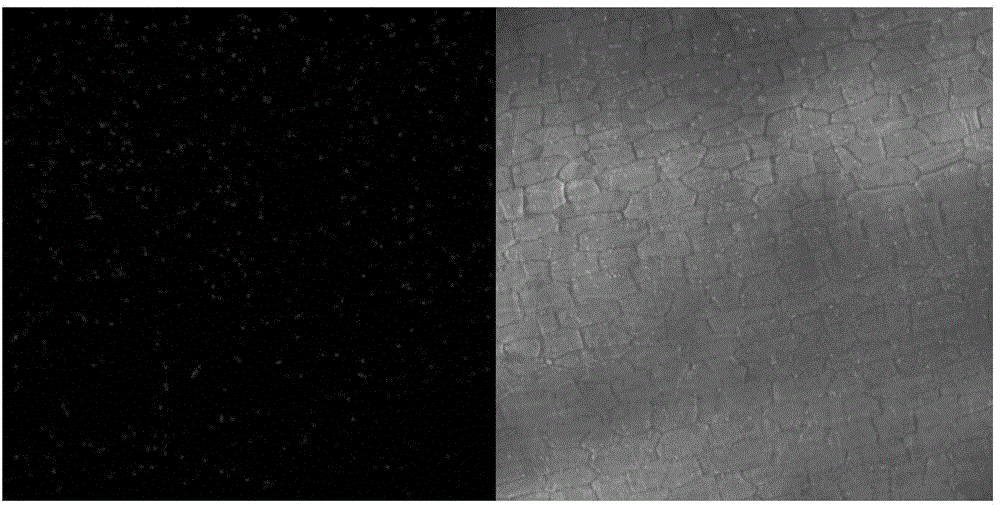Mitochondrial fluorescence labeling method for angiosperm flower organs
An angiosperm, fluorescent labeling technology, applied in fluorescence/phosphorescence, preparation of test samples, material excitation analysis, etc., can solve the problem of lagging research on mitochondria of flower organs, and achieve the effect of good labeling effect and high application value.
- Summary
- Abstract
- Description
- Claims
- Application Information
AI Technical Summary
Problems solved by technology
Method used
Image
Examples
Embodiment 1
[0036] Embodiment 1, the fluorescent labeling method of the tepal mitochondria of Magnolia Magnolia
[0037] 1. Fluorescent labeling of the mitochondria of the tepals of Magnolia magnolia
[0038] The buffer solution containing 100nM Mitotracker Red CMXRos consists of Mitotracker Red CMXRos, sucrose, boric acid and water, the final concentration of Mitotracker Red CMXRos in the buffer solution is 100nM, and the mass percentage of sucrose in the buffer solution is 2% , the mass percentage of boric acid in the buffer solution is 0.01%, and the pH value of the buffer solution is 6.5.
[0039] 1) Take a fresh perianth piece, and peel off 4mm of epidermal monolayer cells on the perianth piece with razor blade tweezers 2 , if it is not a monolayer of cells, lightly scrape the epidermis with a blade until the epidermis on the perianth slices appears transparent, and obtain the treated perianth slices.
[0040] 2) Stain the treated perianth slices in a buffer solution containing 100...
Embodiment 2
[0045] Example 2, Magnolia style mitochondrial fluorescence staining and microscope observation
[0046] 1. Fluorescence labeling of magnolia styloid mitochondria
[0047] The buffer solution containing 100nM Mitotracker Red CMXRos consists of Mitotracker Red CMXRos, sucrose, boric acid and water, the final concentration of Mitotracker Red CMXRos in the buffer solution is 100nM, and the mass percentage of sucrose in the buffer solution is 2% , the mass percentage of boric acid in the buffer solution is 0.01%, and the pH value of the buffer solution is 7.0.
[0048]1) Take a fresh magnolia style, cut the style longitudinally with a blade, and then stick the style on the stage of a Leica VT12000S oscillating microtome with 502 glue. The blade of the slicer and the style are kept at an angle of 30°, and the slice thickness parameter is set to 80 μm. Get the treated style.
[0049] 2) The treated style was stained in a buffer solution containing 100 nM Mitotracker Red CMXRos, an...
Embodiment 3
[0054] Example 3, Rhododendron style mitochondrial fluorescence staining and microscope observation
[0055] The buffer solution containing 200nM Mitotracker Red CMXRos consists of Mitotracker Red CMXRos, sucrose, boric acid and water, the final concentration of Mitotracker Red CMXRos in the buffer solution is 100nM, and the mass percentage of sucrose in the buffer solution is 2% , the mass percentage of boric acid in the buffer solution is 0.01%.
[0056] 1) Take a fresh rhododendron style, cut the style longitudinally with a blade, and obtain a longitudinal section of the style with a slice thickness parameter of 80 μm with a single layer of cells on the edge, which is the treated style.
[0057] 2) The treated style was stained in a buffer solution containing 200 nM Mitotracker Red CMXRos, and stained at 25° C. for 20 min to obtain a stained style. 2. Detection
[0058] The stained style was washed three times with a buffer solution composed of 2% sucrose and 0.01% boric ...
PUM
| Property | Measurement | Unit |
|---|---|---|
| thickness | aaaaa | aaaaa |
Abstract
Description
Claims
Application Information
 Login to View More
Login to View More - R&D
- Intellectual Property
- Life Sciences
- Materials
- Tech Scout
- Unparalleled Data Quality
- Higher Quality Content
- 60% Fewer Hallucinations
Browse by: Latest US Patents, China's latest patents, Technical Efficacy Thesaurus, Application Domain, Technology Topic, Popular Technical Reports.
© 2025 PatSnap. All rights reserved.Legal|Privacy policy|Modern Slavery Act Transparency Statement|Sitemap|About US| Contact US: help@patsnap.com



